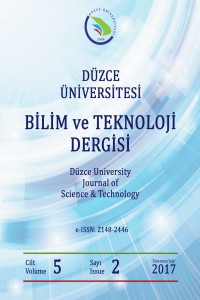Abstract
Günümüz kablosuz dünyasında daha yüksek
kaliteli hizmete olan ihtiyaç sebebiyle, kablosuz haberleşme sistemlerinde,
alıcı ve vericide bir tek anten kullanan sistemler (Single Input Single Output,
SISO) yerine birden fazla anten kullanan çoklu giriş çoklu çıkış (Multiple
Input Multiple Output, MIMO) sistemlerinin kullanılmasına başlanmıştır. Bu
çalışmanın amacı, farklı mimarilerdeki çoklu anten sistemlerini farklı koşullar altında kanal
kapasitesitelerinin belirlenmesi ve karşılaştırmasının yapılmasıdır. Bununla
birlikte MIMO sistemler, yüksek kanal kapasitesi ve yüksek veri hızı ihtiyacını
karşılamaya yönelik teknikler olduklarından, uzaysal çoğullama ve kanal durum
bilgisi teknikleri ile sağlanabilecek kanal kapasitesi analizi de ortaya
konulmaktadır. Ayrıca, çoklu antenlerin
yüksek kanal kapasitesi gerektiren sistemler için çözüm olduğunu göstermek adına,
tek anten sistemleri ve çoklu antenler arasındaki detaylı karşılaştırma
gösterilmektedir. Bunlara ek olarak, hem alıcı hem de vericide çoklu anten
kullanımının sistem kapasitesini artırdığı gösterilmiştir. Sonuçlar
göstermektedir ki, her iki tarafta daha fazla anten kullanımı çeşitlilik ve uzaysal
çoğullama tekniklerinin kullanımına olanak sağlar. Ayrıca yüksek veri hızı ve
güvenilirlik isteyen sistemler için en iyi seçim olarak öne çıkmaktadır.
References
- [1] Nimay Ch. Giri, Anwesha Sahoo, J. R. Swain, P. Kumar, A.Nayak and P. Debogoswami. Sep 2014. ’’ Capacity and Performance Comparison of SISO and MIMO System for Next Generation Network (NGN), International Journal of Advanced Research in Computer Engineering & Technology (IJARCET) Volume 3 Issue 9.page NO. 3031-3035.
- [2] M. A. Khalighi, K. Raoof and G. Jourdain. 2002.’’ Capacity of Wireless Communication Systems Employing Antenna Arrays, a Tutorial Study’’ Wireless Personal Communications 23: 321–352.
- [3] K. Sengar, N. Rani. Mar-2014. “Study and Capacity Evaluation of SISO, MISO and MIMO RF Wireless Communication Systems,” IJETT, Vol. 9, No. 9.
- [4] Y. Devlal and M. Awasthi. Jan. 2015. “Capacity Analysis of MIMO Technology” International Journey of engineering and computer science ISSN: 2319-7242, Vol. 4, page NO. 9819-9824.
- [5] Andreas F. Molisch. 2011. “Wireless Communication”, University of Southern California, USA, Fellow, IEEE, second edition.
- [6] R. Ahmad, D. P. Singh and M. Singh. 2013. ‘’ Ergodic Capacity of MIMO Channel in Multipath Fading Environment’’ I.J. Information Engineering and Electronic Business, 41-48, DOI: 10.5815/ijieeb.
- [7] Yong Soo Cho, Jaekwon Kim, Won Young Yang and Chung G. Kang. 2010. ‘’ MIMO-OFDM Wireless Communication with Matlab’’ IEEE PRESS, John Wiley & Sons.
Channel Capacity Analysis of Multiple Antenna Systems for Next Generation Wireless Communications Systems
Abstract
Nowadays the
wireless world demands to get high quality of service, wireless communication
has been developed by time from using a single antenna at a transmitter and a
single antenna (SISO) at a destination to use multiple antennas at a
transmitter and multiple antennas at a receiver (MIMO). This method give very
efficient results in terms of high quality of services, channel capacity, high
data rate etc. In our studies, we will discuss the comparison of channel
capacity between different multiple antenna systems and similarly what are
their impact in the systems. Since the multiple antenna technique offer the
need from serving high channel capacity and high data rate, spatial
multiplexing and channel state information techniques are explained in detail
to give the reader an overview about advantages of using these techniques.
Moreover, at the end of this study, comparison between single antenna systems
and multiple antennas are made in regards that channel capacity increased by
deploying multiple antennas on both sides and similarly it is one of the best solution
for the systems that require high channel capacity, high data rate as well as
reliability.
References
- [1] Nimay Ch. Giri, Anwesha Sahoo, J. R. Swain, P. Kumar, A.Nayak and P. Debogoswami. Sep 2014. ’’ Capacity and Performance Comparison of SISO and MIMO System for Next Generation Network (NGN), International Journal of Advanced Research in Computer Engineering & Technology (IJARCET) Volume 3 Issue 9.page NO. 3031-3035.
- [2] M. A. Khalighi, K. Raoof and G. Jourdain. 2002.’’ Capacity of Wireless Communication Systems Employing Antenna Arrays, a Tutorial Study’’ Wireless Personal Communications 23: 321–352.
- [3] K. Sengar, N. Rani. Mar-2014. “Study and Capacity Evaluation of SISO, MISO and MIMO RF Wireless Communication Systems,” IJETT, Vol. 9, No. 9.
- [4] Y. Devlal and M. Awasthi. Jan. 2015. “Capacity Analysis of MIMO Technology” International Journey of engineering and computer science ISSN: 2319-7242, Vol. 4, page NO. 9819-9824.
- [5] Andreas F. Molisch. 2011. “Wireless Communication”, University of Southern California, USA, Fellow, IEEE, second edition.
- [6] R. Ahmad, D. P. Singh and M. Singh. 2013. ‘’ Ergodic Capacity of MIMO Channel in Multipath Fading Environment’’ I.J. Information Engineering and Electronic Business, 41-48, DOI: 10.5815/ijieeb.
- [7] Yong Soo Cho, Jaekwon Kim, Won Young Yang and Chung G. Kang. 2010. ‘’ MIMO-OFDM Wireless Communication with Matlab’’ IEEE PRESS, John Wiley & Sons.
Details
| Primary Language | English |
|---|---|
| Subjects | Engineering |
| Journal Section | Articles |
| Authors | |
| Publication Date | July 31, 2017 |
| Published in Issue | Year 2017 Volume: 5 Issue: 2 |


